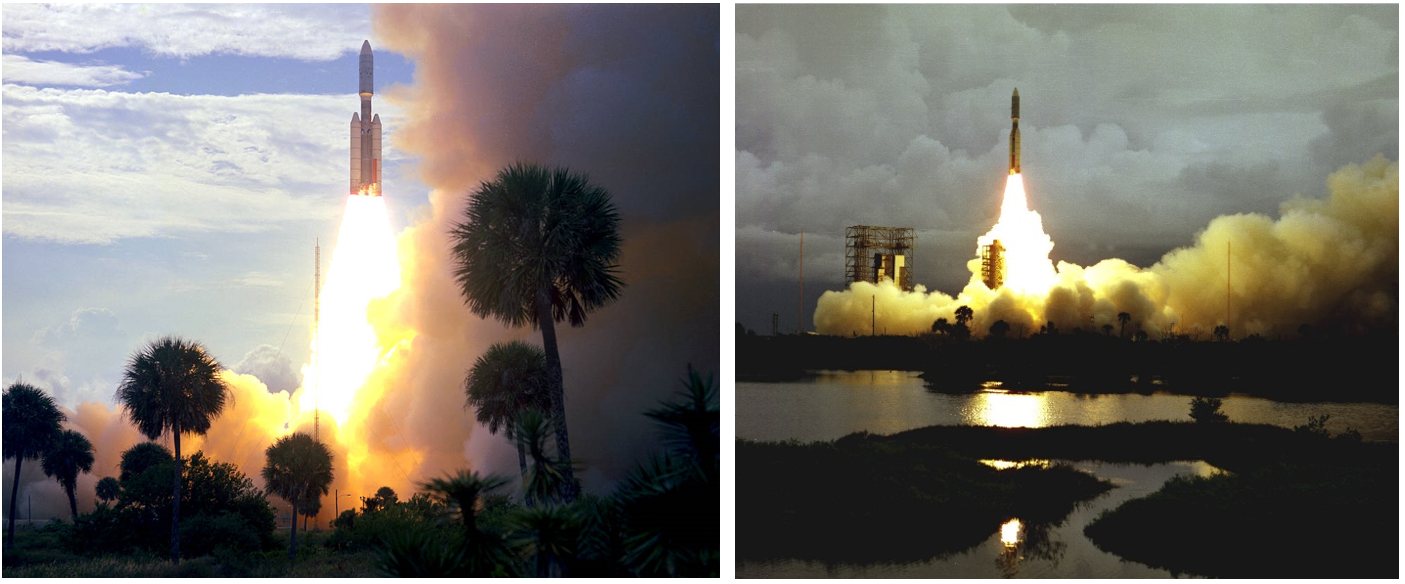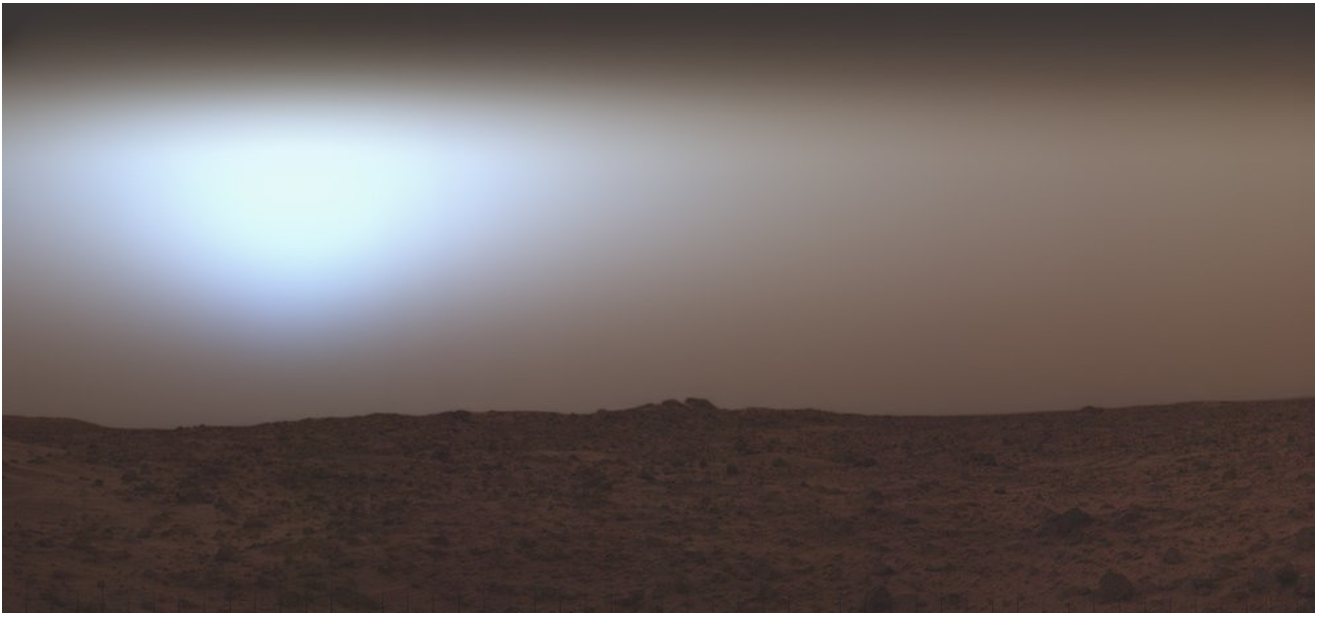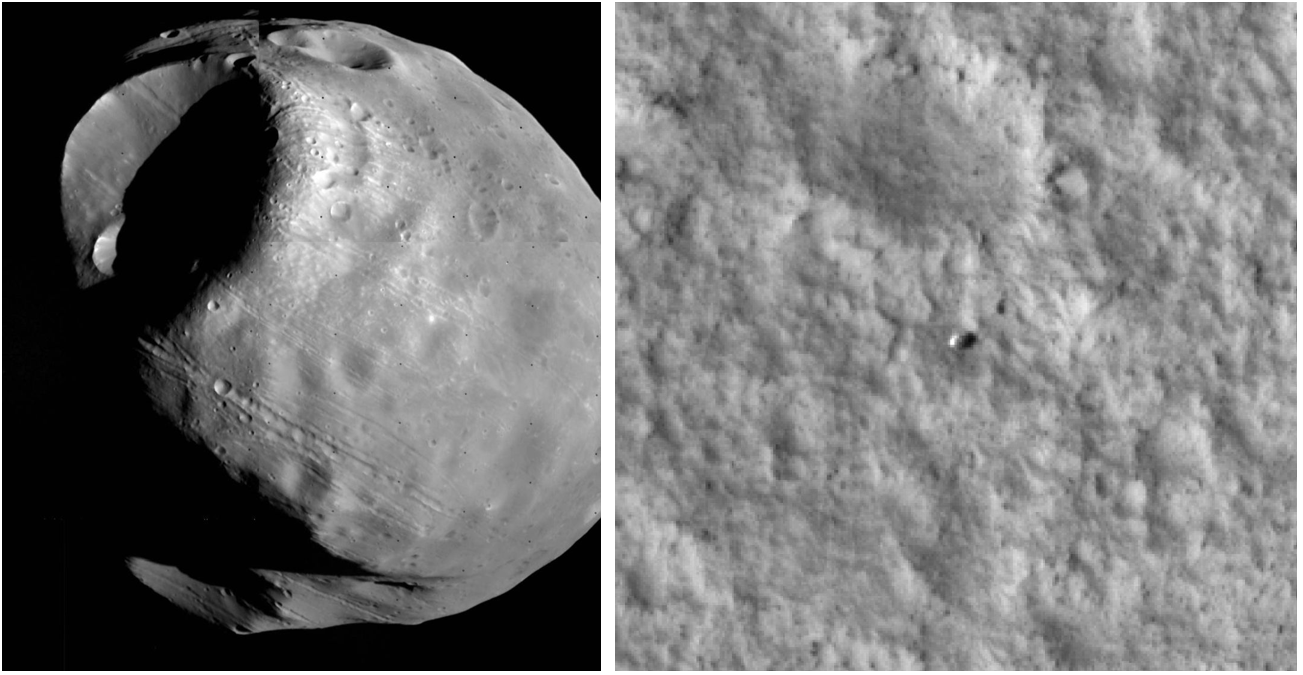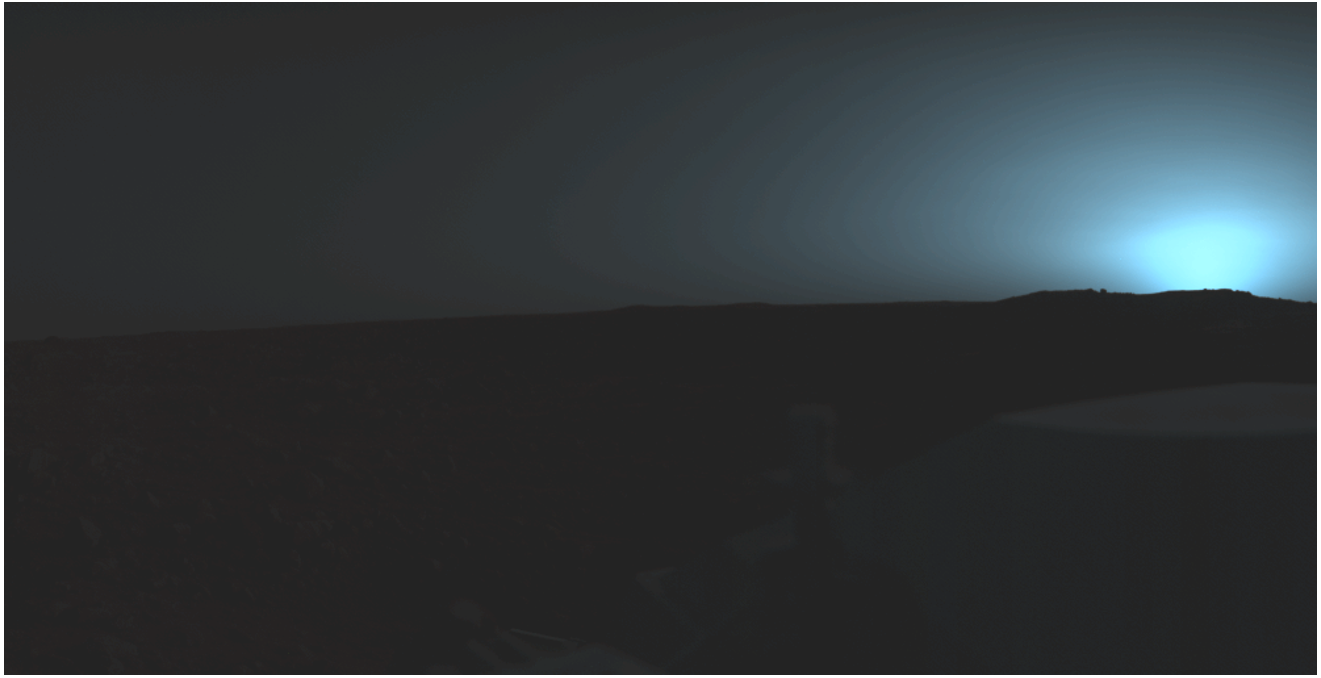45 Years Ago: Viking 1 Touches Down on Mars
In the summer of 1976, a pair of orbiter and lander spacecraft called Viking arrived at Mars. After first entering orbit, Viking 1’s lander touched down on the Red Planet on July 20 — the first U.S. spacecraft to land on another planet. Its twin, Viking 2, arrived a few weeks later. The two orbiters and landers operated well beyond their expected 90 days, returning tens of thousands of photographs and scientific data that dramatically increased our knowledge of Mars, its atmosphere, its surface, and its two moons. They revealed the planet to have been geologically active during its history, with evidence of flowing liquid — possibly water — in the past. The landers’ biology experiments produced no definitive evidence for life on the surface.
 Left: Image of the Viking spacecraft, with the lander encased in its bioshield, at bottom. Right: Cornell University astronomer Carl Sagan stands next to a model of a Viking lander to provide scale. Credits: NASA
Left: Image of the Viking spacecraft, with the lander encased in its bioshield, at bottom. Right: Cornell University astronomer Carl Sagan stands next to a model of a Viking lander to provide scale. Credits: NASA
Does Mars support life, or did it at some point in its history? That question has been on the minds of scientists and lay people alike for a very long time. During brief flyby explorations of the Red Planet in the 1960s, the Mariner 4, 6, and 7 spacecraft returned photos of a heavily cratered lunar-like surface, dashing hopes for an inhabited world. Those hopes revived somewhat in 1971, at least for the potential of past life, after Mariner 9 entered orbit around Mars and returned photographic evidence of features possibly generated by flowing liquid. The next step in Mars exploration involved placing sophisticated landers called Viking on the surface to analyze the Martian soil and atmosphere for a minimum of 90 days. Three biology experiments were designed to search for possible signs of life.
 Launches of Viking 1, left, and Viking 2 from Launch Pad 41 at the Cape Canaveral Air Force Station, now the Cape Canaveral Space Force Station, in Florida. Credits: NASA
Launches of Viking 1, left, and Viking 2 from Launch Pad 41 at the Cape Canaveral Air Force Station, now the Cape Canaveral Space Force Station, in Florida. Credits: NASA
NASA’s Langley Research Center in Hampton, Virginia, managed the Viking project to develop twin spacecraft each consisting of an orbiter, based on the Mariner 9 spacecraft built by the Jet Propulsion Laboratory (JPL), in Pasadena, California, and a lander, built by Martin Marietta under contract to NASA Langley while JPL handled spacecraft operations. Viking 1 lifted off from Launch Complex 41 at Cape Canaveral Air Force Station in Florida, now Cape Canaveral Space Force Station, on Aug. 20, 1975, to begin its 304-day cruise to the Red Planet, followed by Viking 2 on Sept. 9 to start its 320-day voyage.
On June 19, 1976, Viking 1 entered an elliptical orbit around Mars. Although mission managers had planned for the landing to occur on July 4 to coincide with the nation’s bicentennial, photographs taken from orbit showed the original landing site to be rougher than anticipated. A search for a new, safer touchdown point delayed that landing by more than two weeks. On July 20 and, by coincidence, the seventh anniversary of the Apollo 11 Moon landing, the Viking 1 lander separated from the orbiter and began its descent to the surface, making a soft landing in the Chryse Planitia region of Mars. Within five minutes it began sending back the first photograph of its landing site. Viking 2 entered orbit around Mars on July 25, and the second lander made its touchdown in Utopia Planitia on Sept. 3.
 Left: The first photograph ever returned from the surface of Mars, by the Viking 1 lander, including one of its footpads. Right: The first color photograph returned by the Viking 1 lander. Credits: NASA
Left: The first photograph ever returned from the surface of Mars, by the Viking 1 lander, including one of its footpads. Right: The first color photograph returned by the Viking 1 lander. Credits: NASA
 Left: The first photograph returned from the surface of Mars by the Viking 2 lander, including one of its footpads. Right: The first color photograph returned by the Viking 2 lander. Credits: NASA
Left: The first photograph returned from the surface of Mars by the Viking 2 lander, including one of its footpads. Right: The first color photograph returned by the Viking 2 lander. Credits: NASA
Both orbiters and landers far exceeded their expected 90-day lifetimes in their scientific exploration of Mars, vastly increasing our knowledge of the planet, its atmosphere, and its surface. The Viking 1 and 2 orbiters continued their missions until Aug. 17, 1980, and July 24, 1978, respectively, in total returning 52,663 images of Mars and mapping 97% of its surface at a resolution of 300 meters (with selected areas to a resolution of 8 meters). The orbiters also imaged Mars’ two small moons, Phobos and Deimos, providing striking photographs of the irregular objects.
The Viking 1 and 2 landers continued monitoring weather changes at the surface until Nov. 11, 1982, and April 12, 1980, respectively, together returning 4,500 photographs from the two landing sites. The biology experiments produced no definitive evidence of life at either landing site. The Viking 1 lander held the record for the longest operating spacecraft on the surface of Mars at 2,307 Earth days (more than six years) or 2,245 Martian sols, until May 19, 2010, when the Opportunity rover surpassed it.
 View of the Martian sky at sunrise taken by the Viking 1 lander. Credits: NASA
View of the Martian sky at sunrise taken by the Viking 1 lander. Credits: NASA
 Left: View of trenches dug by the Viking lander’s robotic arm to collect soil samples. Right: Photograph of the Viking 2 landing site, including parts of the spacecraft. Credits: NASA
Left: View of trenches dug by the Viking lander’s robotic arm to collect soil samples. Right: Photograph of the Viking 2 landing site, including parts of the spacecraft. Credits: NASA
 Left: Image of the Valles Marineris, the largest canyon in the solar system, taken by the Viking 1 orbiter. Right: View of surface frost at the Viking 2 landing site. Credits: NASA
Left: Image of the Valles Marineris, the largest canyon in the solar system, taken by the Viking 1 orbiter. Right: View of surface frost at the Viking 2 landing site. Credits: NASA
 Left: Mosaic of images of the Martian moon Phobos taken by the Viking 1 orbiter. Right: Image of the Viking 1 lander taken by the Mars Reconnaissance Orbiter in 2006. Credits: NASA
Left: Mosaic of images of the Martian moon Phobos taken by the Viking 1 orbiter. Right: Image of the Viking 1 lander taken by the Mars Reconnaissance Orbiter in 2006. Credits: NASA
 Sunset at the Viking 1 landing site. Credits: NASA
Sunset at the Viking 1 landing site. Credits: NASA
A long hiatus in Mars surface exploration followed the end of Viking operations, with the next lander, NASA’s Mars Pathfinder carrying the Sojourner rover, arriving on July 4, 1997. That mission, along with the insertion of the Mars Global Surveyor into orbit around the Red Planet on Sept. 12, 1997, ushered in an era of continuous robotic exploration of Mars. Since that time, at least one — and, typically, multiple spacecraft — have been operating either in orbit around or on the surface of Mars. The effort has been multinational, with missions sponsored by the United States, ESA (European Space Agency), Russia, India, the United Arab Emirates, and the People’s Republic of China.
For more information about NASA’s Viking missions, please visit NASA’s Mars Exploration Program site.







